Culture Wars
The Posthumous #MeToo-ing of J. D. Salinger
Salinger has been posthumously relegated to the limbo of #MeToo-tainted, “problematic” cultural figures, which probably accounts for the awkward half-silence around his centenary.


The first day of this year would have been the 100th birthday of J.D. Salinger, the American writer whose 1951 novel of teenage rebellion, The Catcher in the Rye, mesmerized generations and made him a cult figure. The Salinger legend was only enhanced by his reclusive life in rural New Hampshire, where he shunned interviewers and photographers and continued to write but published nothing from 1965 until his death in 2010. Given both Salinger’s literary stature and his mythic aura, the centennial should have been a big deal. And yet it went by almost unremarked—a startling fact that almost certainly has more to do with the cultural and sexual politics of this moment than with Salinger’s place in literature.
It is telling that the most prominent essay on Salinger to appear in the American media so far in 2019 has been a Washington Post piecequestioning whether the writer is still relevant, given that his best-known work focuses on “the anxieties of a white heterosexual young man expelled from an expensive prep school.” (By that standard, Hamlet is surely doomed.) And the article raised another issue: the shadow cast over Salinger’s reputation by #MeToo, which had made it unacceptable to “make allowances for abusive behavior by manipulative men.”
Accusations of abusive behavior toward women have haunted Salinger’s memory since his death, gaining more traction with the rise of a victimhood-centered brand of feminism over the past few years. The tipping point came last September with the publication of an essay by Salinger’s former lover Joyce Maynard, published in the New York Times Book Review.

Maynard, who had an ill-fated romance with Salinger in 1972 when he was 53 and she was nineteen, first told her story in the scandalous 1999 memoir, At Home in the World; it earned her both notoriety and opprobrium for invading the reclusive writer’s privacy. The book certainly painted Salinger in a mostly unflattering light—as a self-centered domineering crank, albeit capable of “sweetness and tenderness.” The 2018 essay went much further. This time, Maynard—who expressed disappointment that the #MeToo movement had not led to a re-examination of her story—depicted her experience with Salinger as not just a bad relationship but essentially a violation. She also charged that the criticism she faced twenty years ago was a grotesquely sexist backlash in defense of a famous abuser.
Maynard had already tried to press for a reassessment of Salinger as a predator in 2013, in a New York Times op-ed following the release of a documentary about him. At the time, her piece had limited impact. Five years later, in a changed cultural climate, Maynard found near-unanimous sympathy. Even one of her erstwhile critics, former Time writer Elizabeth Gleick, wrote that the piece made her confront her own “internalized misogyny.”
At least for now, it seems Maynard has won: largely on the strength of her account, Salinger has been posthumously relegated to the limbo of #MeToo-tainted, “problematic” cultural figures, which probably accounts for the awkward half-silence around his centenary. But her victory is hardly a win for justice. For one thing, it has robbed us of the celebration of the legacy of a great American writer. The Catcher in the Rye, which is almost too much of a mythic artifact of its era to be properly appreciated as a novel, is certainly worth a fresh look. It is a work that revolutionized literature, capturing the adolescent voice as no one had before (and that spoke to millions of teens who were not heterosexual white males). And there are the short stories: “Just Before the War with the Eskimos,” “Down at the Dinghy,” “Uncle Wiggily in Connecticut,” “To Esmé—with Love and Squalor,” works of exquisite simplicity and poignancy that have lost none of their effect.
Should this achievement be overshadowed by issues of Salinger’s personal conduct? There is no question that his behavior toward the people in his life, including Maynard, was sometimes appalling. Yet the new narrative casting Maynard as a victim, first of a predatory older man and then of a misogynistic culture, is a crude distortion of a complicated story—one in which men are not the only ones behaving badly.

* * *
That story began when Maynard, whose voice-of-a-generation essay, “An 18-Year-Old Looks Back on Life,” had been published in the New York Times Magazine, found a letter from Salinger among her fan mail. Thrilled by his compliments and predictions of a bright future, Maynard replied. The correspondence led to a meeting, an intense friendship, and finally a sexual relationship (short of full consummation because Maynard was a virgin and all attempts at intercourse were thwarted by her painful vaginal spasms). A scholarship student at Yale, Maynard dropped out at the start of her sophomore year and moved in with “Jerry” at his rural home in Cornish, New Hampshire, alongside his teenage son and daughter who were only a few years her junior.
According to Maynard’s memoir, the New Hampshire idyll quickly soured. “Jerry” not only pressured her to join him on a strict macrobiotic diet but taught her self-induced vomiting to purge unhealthy food like pizza if it was indulged. Despite his high praise for Maynard’s talent and mind, he regularly berated her for everything from her personal habits and tastes to excessive attachment to worldly vanities, including literary success. He was furious at her for giving his number to some editors for contact in that pre-cell phone era, resulting in a call from a Time reporter. He also expected unreciprocated oral sex.
The increasingly frayed relationship ended on a Florida vacation with Salinger’s children. (The trip included a visit to a homeopathic specialist for advice on Maynard’s sexual problems; her verdict was that the problems were entirely psychological.) On a beach outing, Salinger brusquely told Maynard that it was over and instructed her to go back to New Hampshire, collect her things, and leave before he and the kids returned.
An ugly story, to be sure; but Maynard’s condensed account in the Timesmakes it much worse. The oral sex is now described as “forced,” while Salinger becomes a patriarchal tyrant expecting total devotion and subservience from his young paramour: Maynard writes that he “urged [her] to leave college” to live with him and “have babies.”
At Home in the World, however anti-Salinger, tells a rather different story. There’s no mention of Salinger urging Maynard to drop out of Yale; while he fretted about the separation her studies would entail, he actually talked of moving to Connecticut to be near her and drove her to the campus at the start of the term. It was Maynard who decided to leave school and called him to pick her up. While the 2018 essay and the 2013 op-ed assert that she disconnected from friends and family to join Salinger in his near-seclusion, the book not only shows Maynard staying in regular contact with her parents and sister but shows Salinger meeting with them, too. (Some friends are in the picture as well.) Maynard’s time with Salinger coincided with her parents’ tumultuous separation, and she writes that he had long, surprisingly warm phone conversations with her mother, writer and educator Fredelle Maynard, even telling her that the end of her marriage could be an opportunity to pursue the ambitions she had curtailed for her family.
The Times article also offers no hint of the fact that during her eight or nine months with Salinger, Maynard remained active as a journalist/writer and wrote her first book with his encouragement and mentorship. As for the talk of having Salinger’s babies, the memoir leaves no doubt that it was primarily Maynard’s fantasy.
Maynard’s current account includes a repellent yet misleading detail: Salinger, she writes, “put two $50 bills in my hand and instructed me to return to New Hampshire, clear my things out of his house and disappear.” The implication—that he used and discarded her like a prostitute—is obvious. In reality, he gave her the money the day after the breakup when he put her in a cab to go to the airport: Maynard had not taken any cash on the trip, and in 1972 you could not get far without cash.
There is no question that Maynard’s experience with Salinger was traumatic. Her self-worth was wrecked by his constant criticism (though, interestingly, she admits that many of his comments about the flaws in her writing were on-target). After the relationship ended, Maynard not only spent months pining and begging him to take her back but sank the money from her book into a rural home about fifty miles from Cornish, in the hope that she could win “Jerry’s” heart by imitating his lifestyle.

And yet was this relationship anything other than consensual? It’s hard to make that case without drastically downgrading female autonomy. Maynard writes that she began to see her relationship with Salinger “through an utterly altered lens” when her daughter reached the age she had been at the time: imagining her child in her own place, she began to see her younger self as “deserving of protection and care.” An understandable impulse—but also one that arguably taps into the protectiveness toward women that feminists once identified as a source of pernicious, freedom-limiting paternalism.
The age gap matters, of course. Maynard’s youth—coupled with her dysfunctional family background as the child of an alcoholic father and a frustrated mother, and with Salinger’s aura as a great writer—made her far more vulnerable to psychological coercion. But inequalities exist in many relationships, age-disparate or not. Where do we draw the line to decide that these inequalities invalidate consent? How do we measure “power differentials” in situations where neither party has tangible, institutional power over the other?
These questions resonate with me, in part because I have my own somewhat Maynard-like story. I too got published at that age—in a Russian-language newspaper in New York, as a recent immigrant from the Soviet Union—and received a fan letter from an older male writer with whom I eventually got involved in a not-quite-consummated relationship. We too talked of marriage and being a creative team. In my case, the man was in his early thirties, not his fifties, and not a famous author but a marginally employed, alcoholic Russian immigrant with an unpublished book that he said would revolutionize philosophy. Obviously, I attracted a lower class of inappropriate older boyfriend than Maynard, but ironically this also made it easier to extricate myself—which I did after about three months, once I figured out that my would-be husband was not an unappreciated genius and was not going to stop drinking. It was a bad experience, and it’s fair to say I didn’t quite know what I was doing. (Probably the only positive thing to come out of it was that almost any boyfriend after that looked good to my parents.) But to say that it was somehow not quite consensual would be insulting—not only to actual victims of sexual coercion, but to me as an adult, however young.
What does sound much more like sexual abuse is Maynard’s brief account of some very peculiar behavior by her mother. Fredelle Maynard apparently had a habit of sharing “cuddle time” in bed with her pubescent daughter while wearing “almost transparent nightgowns” through which young Joyce could see her mother’s breasts. These snuggling sessions included kissing on the lips (including a type of kiss nicknamed “Suction”), jokes about Joyce’s nipples, and occasional inspections to see if her pubic hair was growing. Sometimes, Fredelle would also rub an herbal balm on her daughter’s vagina, to no discernible purpose.
Maynard makes no mention of this in her #MeToo narrative. She does, however, insinuate that Salinger was a serial predator because he also corresponded with other teenage girls—even though there is no evidence that these correspondences were anything but platonic, or that he was “grooming” them for sex in any way. Maynard’s 2013 piece includes the disturbing claim that “one of these girls, 14 when Salinger first pursued her … reports that he severed their relationship the day after their one and only sexual encounter.” But what he pursued was friendship, not sex; the woman, Jean Miller—who, much to Maynard’s exasperation, still admires Salinger—has unambiguously stated that it was she who pursued him sexually when she was 20. (Salinger was in his early forties.)
Maynard’s claim to have been victimized by the press are just as skewed. Yes, some of the anti-Maynard backlash in the late 1990s was vicious and unfair. Some critics acted as if it was a moral offense for her to tell her own story because it violated Salinger’s privacy; there were those who branded her a predator and an exploiter, especially after she auctioned off a trove of Salinger’s letters. (The buyer returned them to Salinger.) But most negative reviews of At Home in the World acknowledged that Salinger had behaved badly; Gleick, the Time writer who later chastised herself for “internalized misogyny,” even called him a “brute.” The critics simply felt that Maynard was something of a bad actor in her own right, and even the sympathetic feminist reviewer Katha Pollitt in the New York Times took her to task for her lack of introspection.
* * *
Whatever one may think of At Home in the World, it is a vivid, fascinating, and mostly believable, if unpleasant, glimpse into Salinger’s life after his withdrawal from public view. Maynard’s #MeToo essay, on the other hand, gives us nothing new or insightful; it is little more than an attempt to reframe the story with Salinger as a sexual abuser. In that, Maynard fails.
Salinger’s friendships with adolescent girls will undoubtedly look creepy and weird to many people; others will see them as an expression of the writer’s own lifelong childlike nature, an extension of his well-known fascination with the innocence of youth. Was there a sexual element to this fascination? He certainly never sexualizes children in his fiction (including the lovely character inspired by his real-life friendship with Miller, 13-year-old Esmé, who befriends an American G.I. in the wartime story “To Esmé —with Love and Squalor”). It is also worth noting that both of Salinger’s known romantic relationships post-Maynard were with much younger but mature women: television actress Elaine Joyce, whom he dated when she was in her mid-thirties, and nurse Colleen O’Neill, whom he married in 1988 when she was 29.
Few would deny that Salinger was a man with many faults—including an obsession with various forms of quackery—and with psychological problems that could make other people’s lives very difficult. (At least some of those issues undoubtedly go back to war trauma; Salinger was not in combat but served in a regiment that suffered extremely high casualties.) Much of his life remains a mystery; but the #MeToo brand of feminism that pits men against women can only impede attempts to understand it.
Salinger’s daughter Margaret, whose memoir Dream Catcher appeared two years after At Home in the World, depicts him as emotionally abusive to his family, including his second wife Claire Douglas. But his son Matt has strongly disputed that account, and Douglas has also denied some of its elements. Should we “believe women” and assume that Matt Salinger is either covering up for his father out of patriarchal solidarity or blind to abuse because of male privilege? Should we take Margaret Salinger’s word over her mother’s? Should we assume that women like veteran journalist Janet Malcolm, whose 2001 essay in the New York Review of Books referred to Maynard’s and Margaret Salinger’s oeuvre as “crass, vengeful memoirs,” have been mere handmaidens to the patriarchy?
Questions about Salinger’s work and life will be with us for a while, though they will have to wait for a better cultural moment. The consolation is that Salinger’s books will still be read when the current politics of gender and identity have faded into irrelevance.






